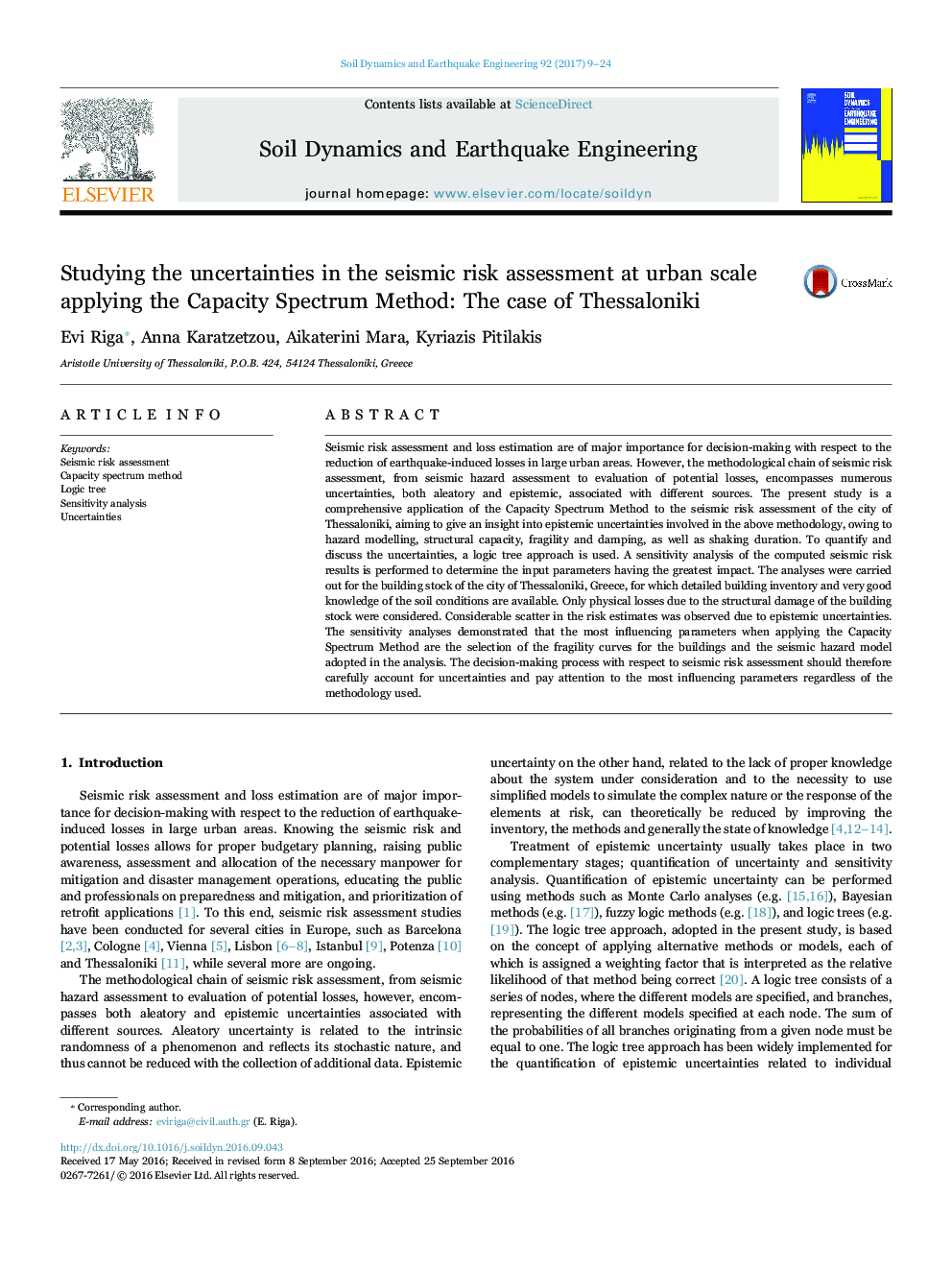| کد مقاله | کد نشریه | سال انتشار | مقاله انگلیسی | نسخه تمام متن |
|---|---|---|---|---|
| 4927149 | 1431701 | 2017 | 16 صفحه PDF | دانلود رایگان |
عنوان انگلیسی مقاله ISI
Studying the uncertainties in the seismic risk assessment at urban scale applying the Capacity Spectrum Method: The case of Thessaloniki
ترجمه فارسی عنوان
بررسی عدم قطعیت در ارزیابی ریسک لرزه ای در مقیاس شهری با استفاده از روش طیف طیفی: مورد تسالونیکی
دانلود مقاله + سفارش ترجمه
دانلود مقاله ISI انگلیسی
رایگان برای ایرانیان
کلمات کلیدی
ارزیابی ریسک لرزه ای، روش طیف ظرفیت درخت منطق، تجزیه و تحلیل میزان حساسیت، عدم اطمینان،
ترجمه چکیده
ارزیابی ریسک لرزه ای و برآورد ضرر برای تصمیم گیری با توجه به کاهش تلفات ناشی از زلزله در مناطق شهری مهم است. با این حال، زنجیره روش شناسی ارزیابی خطر لرزه ای، از ارزیابی خطر لرزه ای تا ارزیابی تلفات بالقوه، شامل عدم اطمینان های متعدد است، هر دو علمی و معرفتی، همراه با منابع مختلف. این مطالعه یک کاربرد جامع از روش طیف طیفی برای ارزیابی ریسک لرزه ای شهر تسالونیکی است که هدف آن ارائه بینش به عدم شناخت معرفتی در روش شناسی فوق است که به دلیل مدل سازی خطر، ظرفیت ساختاری، شکنندگی و سقوط، به عنوان خوب به عنوان مدت زمان تکان دادن. برای اندازه گیری و بحث در مورد عدم اطمینان، یک روش درخت منطق استفاده می شود. تجزیه و تحلیل حساسیت نتایج ریسک لرزه ای محاسبه شده برای تعیین پارامترهای ورودی با بیشترین تأثیر انجام شده است. تجزیه و تحلیل ها برای ساختمان ساختمان شهر تسالونیکی، یونان انجام شده است که برای آن موجودی ساختمان دقیق و دانش بسیار خوبی از شرایط خاک موجود است. تنها زیان های فیزیکی ناشی از آسیب های ساختاری سازه ساختمان در نظر گرفته شد. پراکندگی قابل توجهی در برآورد ریسک به علت عدم قطعیت معرفتی مشاهده شد. تجزیه و تحلیل حساسیت نشان داد که بیشترین پارامتر تأثیرگذار در هنگام استفاده از روش طیف طیفی، انتخاب منحنی های شکننده برای ساختمان ها و مدل خطر لرزه ای است که در تجزیه و تحلیل مورد استفاده قرار گرفته است. بنابراین تصمیم گیری در رابطه با ارزیابی ریسک لرزه ای باید به دقت بر عدم قطعیت ها توجه کند و توجه به پارامترهای تاثیر گذار را بدون توجه به روش شناسی مورد استفاده قرار دهد.
موضوعات مرتبط
مهندسی و علوم پایه
علوم زمین و سیارات
مهندسی ژئوتکنیک و زمین شناسی مهندسی
چکیده انگلیسی
Seismic risk assessment and loss estimation are of major importance for decision-making with respect to the reduction of earthquake-induced losses in large urban areas. However, the methodological chain of seismic risk assessment, from seismic hazard assessment to evaluation of potential losses, encompasses numerous uncertainties, both aleatory and epistemic, associated with different sources. The present study is a comprehensive application of the Capacity Spectrum Method to the seismic risk assessment of the city of Thessaloniki, aiming to give an insight into epistemic uncertainties involved in the above methodology, owing to hazard modelling, structural capacity, fragility and damping, as well as shaking duration. To quantify and discuss the uncertainties, a logic tree approach is used. A sensitivity analysis of the computed seismic risk results is performed to determine the input parameters having the greatest impact. The analyses were carried out for the building stock of the city of Thessaloniki, Greece, for which detailed building inventory and very good knowledge of the soil conditions are available. Only physical losses due to the structural damage of the building stock were considered. Considerable scatter in the risk estimates was observed due to epistemic uncertainties. The sensitivity analyses demonstrated that the most influencing parameters when applying the Capacity Spectrum Method are the selection of the fragility curves for the buildings and the seismic hazard model adopted in the analysis. The decision-making process with respect to seismic risk assessment should therefore carefully account for uncertainties and pay attention to the most influencing parameters regardless of the methodology used.
ناشر
Database: Elsevier - ScienceDirect (ساینس دایرکت)
Journal: Soil Dynamics and Earthquake Engineering - Volume 92, January 2017, Pages 9-24
Journal: Soil Dynamics and Earthquake Engineering - Volume 92, January 2017, Pages 9-24
نویسندگان
Evi Riga, Anna Karatzetzou, Aikaterini Mara, Kyriazis Pitilakis,
